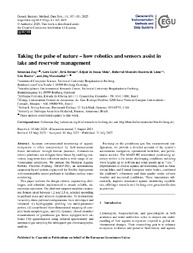Taking the pulse of nature: how robotics and sensors assist in lake and reservoir management.
Taking the pulse of nature: how robotics and sensors assist in lake and reservoir management.
Autoria: ZUG, S.; LICHT, G.; BÖRNER, E.; MOTA, E. de S.; LIMA, R. M. B. de; ROEDER, E.; MATSCHULLAT, J.
Resumo: Accurate environmental monitoring of aquatic ecosystems is often compromised by field-measurement biases introduced through human presence. Autonomous robotic platforms can mitigate these biases by enabling consistent, long-term data collection under a wide range of environmental conditions. We present the Modular Aquatic Robotic Platform–Freiberg (MARP-FG), an autonomous, catamaran-based system engineered for flexible deployment with customizable sensor payloads to facilitate surface water monitoring. This paper outlines the design criteria, engineering challenges, and solutions implemented to ensure reliable, autonomous operation. The platform supports modular catamaran floaters sized between 1.2 and 2.5?m, selected according to payload mass and mission requirements. To demonstrate versatility, three payload configurations were developed and validated: (i) hydrographic profiling via multi-parameter probes, (ii) sonar-based three-dimensional mapping of complex basin morphologies, and (iii) dynamic closed-chamber measurements of greenhouse gas fluxes equipped with onboard CO2 quantification using infrared spectrometry and automated gas sampling for subsequent gas chromatographic analysis. Focusing on the greenhouse gas flux measurement configuration, we provide a detailed account of the system's autonomous navigation, operational workflow, and performance metrics. The MARP-FG maintained positioning accuracy within ±2?m under challenging conditions including wave heights up to ±40?cm and wind speeds up to 7?m?s?1. Deployments in diverse aquatic environments, such as Amazonian lakes and Central European water bodies, confirmed the platform's robustness and data quality under adverse weather and nocturnal conditions. These innovations substantially improve automated aquatic monitoring capabilities, offering a versatile tool for long-term geoscientific data acquisition.
Ano de publicação: 2025
Tipo de publicação: Artigo de periódico
Unidade: Embrapa Florestas
Observações
1 - Por padrão são exibidas publicações dos últimos 20 anos. Para encontrar publicações mais antigas, configure o filtro ano de publicação, colocando o ano a partir do qual você deseja encontrar publicações. O filtro está na coluna da esquerda na busca acima.
2 - Para ler algumas publicações da Embrapa (apenas as que estão em formato ePub), é necessário ter, no celular ou computador, um desses softwares gratuitos. Sistemas Android: Google Play Livros; IOS: iBooks; Windows e Linux: software Calibre.
Acesse outras publicações
Acesse a Base de Dados da Pesquisa Agropecuária (BDPA) para consultar o acervo completo das bibliotecas da Embrapa.

